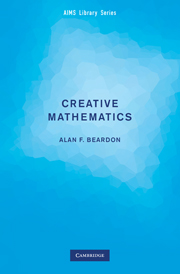8 - Problem D: Solution
Published online by Cambridge University Press: 16 May 2024
Summary
First, we consider the simpler problem of two tetrahedral dice with positive integers on their faces. As the sum of the scores is at most 8, none of the integers on the faces can be greater than 7. Thus there are only a finite number of possibilities and we could use a computer to list all possibilities with the correct probability distribution. However, it might be more efficient (and is probably more interesting) to argue directly.
We label the first die with the integers a, b, c, d, and the second die with the integers A,B,C,D, where
and we assume that this gives us a solution to the problem. As we can obtain a total of 2 in exactly one way, we must have a = A = 1, and b ≥ 2 and B ≥ 2. Also, as we can obtain a total of 8 in exactly one way, we must have d + D = 8, c < d andC <D. Thus
Next, as we can obtain a total of 3 in exactly two ways, we must have exactly two of the labels equal to 2. Either each die has exactly one label of 2, or one die, say the first, has two labels of 2. Thus we now have these two possibilities:
In (1), d ≥ 4,D ≥ 4, and d + D = 8; thus d = D = 4 and, in this case, we have the standard tetrahedral dice.
In (2), D ≥ 4. As 8 − D = d ≥ 3 we also see that D ≤ 5; thus D is 4 or 5. If D = 4 then d = 4 and B = C = 3, and we can easily check that this is not a solution. Thus, in (2) we must have d = 3 and D = 5. It is now easy to see that we must also have B = C = 3, and hence, in case (2), the only possible solution is to label the dice ﹛1, 2, 2, 3﹜ and ﹛1, 3, 3, 5﹜. To complete our solution it is necessary to check that these labels give the correct totals and frequency distribution, as our discussion has been based on the (possibly false) assumption that a nonstandard solution exists.
- Type
- Chapter
- Information
- Creative MathematicsA Gateway to Research, pp. 41 - 44Publisher: Cambridge University PressPrint publication year: 2009



